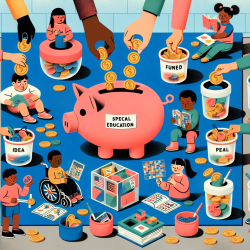Special education funding in Washington State can seem complex, but understanding the basics can help educators, parents, and administrators better navigate the system. Here, we'll break down the key components of special education funding and provide a clear example to illustrate how it works.
Two Primary Revenue Sources
In Washington State, special education services are supported by two main revenue sources:
- Basic Education
- Special Education
Every student receiving special education and related services is first and foremost a basic education student. This means they receive funding from the basic education allocation (BEA) before any additional special education funds are applied.
Understanding the State Special Education Formula
The state special education formula is divided into two parts:
- Funding for students ages 3–5 who are not enrolled in kindergarten and are eligible for and receiving special education services.
- Funding for students ages 5–21 who are eligible for and receiving special education services and enrolled in K–12.
Special education funding is provided in addition to the full BEA, which results in two primary sources of revenue for supporting special education services: basic education and special education.
Allocation Formulas Explained
For Students Ages 3–5 Not Enrolled in Kindergarten
The funding formula for these students is:
Annual average headcount of students * District's BEA * 1.2
Example: - Your district has 10 students, ages 3–5 not enrolled in kindergarten, and eligible for special education services.
- Your district's BEA is $5,022.90
- Your district receives $60,274.80
Calculation: 10 students * $5,022.90 * 1.2 = $60,274.80
For Students Ages 5–21 Enrolled in K–12
The funding formula for these students involves a tiered system:
- Tier 1: Multiplier of 1.12 for students who spend 80% or more of their school day in general education settings.
- Tier 2: Multiplier of 1.06 for students who spend less than 80% of their school day in general education settings.
The formula is:
Annual average headcount of students * District's BEA * Special Education Cost Multiplier Rate
Example: - Your district has 100 students with IEPs in Tier 1
- Your district has 60 students with IEPs in Tier 2
- Your district is over the 15% threshold by 1%
- Your district's BEA is $5,022.90
- Your district's Fed Funds Integration Rate Per Student is $17.75
Calculation: - Tier 1 Multiplier: 100 * ($5,022.90 * 1.12) – 17.75) = $560,789.80
- Tier 2 Multiplier: 60 * ($5,022.90 * 1.06) – 17.75) = $318,391.44
- Percent of Special Ed Students: (100 + 60) / 1,000 = 16.0%
- Percent over 15% threshold: 16.0% - 15% = 1%
- Excess funding: (($560,789.8 + $318,391.44)/16.0%) * 1% = $54,948.82
- Total Allocation: $560,789.8 + $318,391.44 - 54,948.82 = $824,232.42
State Special Education Funding For Districts
To access detailed funding information for your district, follow these steps:
- Navigate to the Apportionment, Enrollment, and Fiscal Reports on the OSPI website.
- Select "Apportionment," then your district from the drop-down menu.
- Choose the Apportionment report; the current month is sorted at the top of the list.
- Search for the 1191SE Special Education Report.
For more information, please follow this
link.










